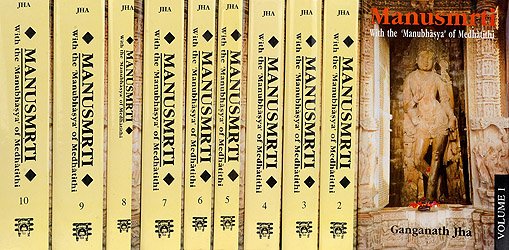Manusmriti with the Commentary of Medhatithi
by Ganganatha Jha | 1920 | 1,381,940 words | ISBN-10: 8120811550 | ISBN-13: 9788120811553
This is the English translation of the Manusmriti, which is a collection of Sanskrit verses dealing with ‘Dharma’, a collective name for human purpose, their duties and the law. Various topics will be dealt with, but this volume of the series includes 12 discourses (adhyaya). The commentary on this text by Medhatithi elaborately explains various t...
Verse 5.18
Sanskrit text, Unicode transliteration and English translation by Ganganath Jha:
श्वाविधं शल्यकं गोधां खड्गकूर्मशशांस्तथा ।
भक्ष्यान् पञ्चनखेष्वाहुरनुष्ट्रांश्चैकतोदतः ॥ १८ ॥śvāvidhaṃ śalyakaṃ godhāṃ khaḍgakūrmaśaśāṃstathā |
bhakṣyān pañcanakheṣvāhuranuṣṭrāṃścaikatodataḥ || 18 ||Among five-nailed animals they declare the porcupine, the hedge-hog, the alligator, the rhinoceros, the tortoise and the hare, as fit to be eaten; as also all animals having one line of teeth. except the camel.—(18)
Medhātithi’s commentary (manubhāṣya):
Among five-nailed animals, the Porcupine and the rest are fit to be eaten.
In another Smṛti, there is option regarding the Rhinoceros. Says Vaśiṣṭha (14-4?)—‘They dispute about the rhinoceros.’
With the exception of the camel, all those animals are fit to be eaten which have only one line of teeth: for instance, the cow, the gout and the deer.
“In as much as the present verse specifies the porcupine &c. as alone fit to be eaten, among five-nailed animals,—it follows that all the other five-nailed animals are unfit to be eaten; so that the prohibition of ‘all five-nailed animals’ becomes entirely superfluous.”
There is nothing wrong in this. When the prohibition is stated in so many words, our comprehension of it is direct; if on the other hand, we were to derive our knowledge of what should not be eaten from the specification of what should be eaten, our comprehension of the prohibition would be only inferential, indirect; and this would he a complicated process.—(18).
Explanatory notes by Ganganath Jha
This verse is quoted in Mitākṣarā (on 1.177);—in Vīramitrodaya (Āhnika, p. 545), which explains ‘ekatodataḥ’ as ‘those that have only one line of teeth’;—and in Smṛtisāroddhāra (p. 299).
Comparative notes by various authors
(verses 5.17-18)
See Comparative notes for Verse 5.17.
